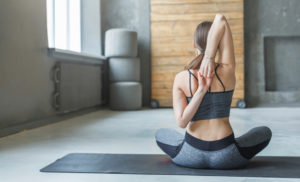The Locust (Salabhasana) Pose
Focus: Spine
Total Time: 30 to 60 seconds
Indications: constipation, gas, lower back pain, exhaustion
The Locust (Salabhasana) Pose
The Locust (Salabhasana) Pose focuses on building strength in your spine as well as the backs of your arms, legs, and hips, all while simultaneously stretching your thighs, chest, stomach and shoulders. The Locust (Salabhasana) Pose can help you fight stress while improving your posture. Experts believe that The Locust (Salabhasana) Pose can offer relief for constipation, gas, exhaustion and lower back pain. Those with a headache or a major back injury should avoid The Locust (Salabhasana) Pose. Individuals with a neck injury may want to use a thick blanket to support their forehead during The Locust (Salabhasana) Pose.
 Begin by lying face down on your stomach with your arms at your sides, palms facing up. Turn your thighs inward by rotating your big toes toward each other. Tense your hips so that your tailbone pushes into your pubis.
Begin by lying face down on your stomach with your arms at your sides, palms facing up. Turn your thighs inward by rotating your big toes toward each other. Tense your hips so that your tailbone pushes into your pubis.
 Breathe in. Raise your head, upper body, legs and arms off the ground. Tense your hips again and actively reach through your legs towards the soles of your feet and toes. Your big toes should stay facing each other. Raise your arms parallel to the ground and extend back through the tips of your fingers as you push into the sky. Strongly press your shoulder blades together.
Breathe in. Raise your head, upper body, legs and arms off the ground. Tense your hips again and actively reach through your legs towards the soles of your feet and toes. Your big toes should stay facing each other. Raise your arms parallel to the ground and extend back through the tips of your fingers as you push into the sky. Strongly press your shoulder blades together.
 Stare ahead while keeping your head stable. The back of your neck should be long with your head raised.
Stare ahead while keeping your head stable. The back of your neck should be long with your head raised.
 Stay in this position for 30 to 60 seconds. To release yourself from this position, breathe out, lower your body to the ground, rest, and take a few breaths.
Stay in this position for 30 to 60 seconds. To release yourself from this position, breathe out, lower your body to the ground, rest, and take a few breaths.
The Locust (Salabhasana) PoseFocus: SpineLevel: BeginnerTotal Time: 30 to 60 secondsIndications: constipation, gas, lower back pain, exhaustion Contraindications: headache, major back injury; modification for neck injuryThe Locust (Salabhasana) PoseThe Locust (Salabhasana) Pose focuses on building strength in your spine as well as the backs of your arms, legs, and hips, all while simultaneously stretching your thighs, chest, stomach and shoulders. The Locust (Salabhasana) Pose can help you fight stress while improving your posture. Experts believe that The Locust (Salabhasana) Pose can offer relief for constipation, gas, exhaustion and lower back pain. Those with a headache or a major back injury should avoid The Locust (Salabhasana) Pose. Individuals with a neck injury may want to use a thick blanket to support their forehead during The Locust (Salabhasana) Pose. Begin by lying face down on your stomach with your arms at your sides, palms facing up. Turn your thighs inward by rotating your big toes toward each other. Tense your hips so that your tailbone pushes into your pubis. Breathe in. Raise your head, upper body, legs and arms off the ground. Tense your hips again and actively reach through your legs towards the soles of your feet and toes. Your big toes should stay facing each other. Raise your arms parallel to the ground and extend back through the tips of your fingers as you push into the sky. Strongly press your shoulder blades together.Stare ahead while keeping your head stable. The back of your neck should be long with your head raised. Stay in this position for 30 to 60 seconds. To release yourself from this position, breathe out, lower your body to the ground, rest, and take a few breaths. Read More
Read More








